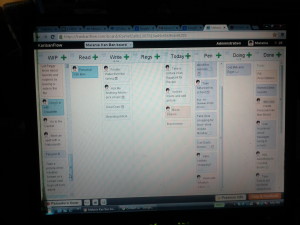Why I Stayed Up All Night Making a Personal Kanban and Why You Should Too!
For the last couple of years I have been doing some work with a great guy named Kevin Behr who wrote The Phoenix Project. He works in the space of IT and continuous improvement and helps organizations get better at what they do. One of the ways they get better fast is to control Work in Progress or WIP, which led me to the concept of “Kanban” (rhymes with bonbon) and I’ve been curious about it for a while now. What’s a Kanban, you might ask…
Here’s what Wikipedia has to say:
Kanban (かんばん(看板)?) (literally signboard or billboard) is a scheduling system for lean and just-in-time (JIT) production.[2]Kanban is a system to control the logistical chain from a production point of view, and is not an inventory control system. Kanban was developed by Taiichi Ohno, at Toyota, to find a system to improve and maintain a high level of production. Kanban is one method through which JIT is achieved.[3]
Kanban became an effective tool in support of running a production system as a whole, and it proved to be an excellent way for promoting improvement. Problem areas were highlighted by reducing the number of Kanban in circulation.
That all sounds great for manufacturing, right? But why would I want a personal Kanban? I asked Kevin for a book recommendation to further explore the Kanban concept and he recommended Personal Kanban: Mapping Work | Navigating Life by Jim Benson. It is about using a Kanban system to help organize the complex and disparate tasks we all juggle.
That is why last night I woke up in the middle of the night and spent a couple of hours creating my own personal Kanban. This book is almost diabolically simple and yet offers a solution to the management of life’s complexity by “managing work.” This idea of calling the complex lists of tasks in my life “work” helps me think about them in a new way. The book suggests we can only focus on one task at a time, thus we should only be actually working on a small number of tasks at any given time. The author suggests no more than 3 tasks.
He suggests post it notes and whiteboard to create the first personal Kanban, but since I was reading all this in bed and was keen to get started–remember, it was the middle of the night and my “to do” list was keeping me awake worrying, I decided to see if I could
find an online tool, preferably with an app I could use on my phone. I found Kanban Flow, a free online Kanban tool that does exactly what I was hoping it would do. I set it up and was wildly happy with the results.
I ended up with 8 columns–substantially more than Benson’s recommendation of 3-5 columns. He recommends 3 columns for a basic Kanban: Work, Doing, Done. Or for 5 columns he recommends adding columns: Today (what I will accomplish today) and Pen (this is used for parking items waiting for something from someone else). I added 3 more columns: Writing (the next 4 articles I need to write), Reading (books I want to read), and something I call “Regs” (regular things I do). I wanted the Regs column to be a reminder of what I do during a day. When I finish coaching for the day or the milk and eggs I pick up twice each week, I wanted there to be a tangible reminder that these things are happening in my life and I am accomplishing them. They are repeat events. We’ll see if it works.
I am feeling so grounded and powerful with my Kanban in place. I color coded one section “Family” and I notice just how many of these “Family” tasks I am doing right now, as I help out both my parents and my 20-year-old daughter. It makes sense that I have been feeling like my plate is very full.
Anyway, I am loving the book, the concept of the Kanban, and the Kanban Flow tool. I think everyone should try the concept of the Personal Kanban–I think it is a stellar solution to a complex world! Please consider giving it a try, and I’d love to hear your feedback in the Comments section below.
1 Comment
Leave a Comment
You must be logged in to post a comment.





I got totally inspired by this post and I just created a Kanbanflow account. Loved that the tutorial takes two minutes and now I have a basic set up… already! I’m going to mess around with it and report back. Neat that it’s a visual organizational tool – I really respond well to that – thanks for the recommendation Melanie!